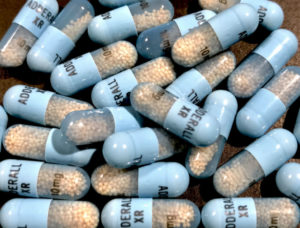 The best drug brand names sound like an alien language: Opdivo, Xarelto, Vraylar, Keytruda, Jardiance, Chantix, Taltz. Some roll off the tongue: Lyrica, Trulicity, Eylea, Seretide, Xeljanz (my current favorite). Others clank: Farxiga, Pristiq. But they always fascinate. They have a weird music all their own.
The best drug brand names sound like an alien language: Opdivo, Xarelto, Vraylar, Keytruda, Jardiance, Chantix, Taltz. Some roll off the tongue: Lyrica, Trulicity, Eylea, Seretide, Xeljanz (my current favorite). Others clank: Farxiga, Pristiq. But they always fascinate. They have a weird music all their own.
Big Pharma speaks a strange language, but that should come as no surprise. The brand names are nonsense words by design. Cooked up by multimillion-dollar ad departments, they are every bit as artificial as the substances they name. Yet they make up an increasingly important part of the language we inhabit. They shape the vocabulary of affliction and of addiction. They are the words for problem and the words for cure.
They are also a lot of fun, from a distance—a kind of a language game. Tangles of regulations from the FDA, WHO, and others comprise the rules. First, a drug’s brand name cannot suggest which body part or ailment it might treat. Otherwise we would be buying simpler things: Hurtless, or Depresso. The name must correlate to the condition obliquely, if at all. Second, a drug’s brand name cannot be too similar to any other drug that has ever existed. This is to prevent consumer confusion, the wrong pill taken at the wrong time. After all, “medical error” is the third-leading cause of death in the United States after heart disease and cancer, according to a recent British study. (Though the euphemistic blanket term “medical error” conceals a lot, as it can include death by suicide or overdose in addition to mere pill mix-ups.) Third, the drug’s name cannot hint too clearly at what it might contain; it cannot suggest the presence of a salt, a metal, ginger root, or any other specific ingredient at all. This further distances the word from the everyday language we use to name things. Finally, the chosen name must pass all of these difficult tests not only in English, but also in the languages of every country in which it will be marketed. Xeljanz is meaningless not only in English, but also in many other European languages—and in Mandarin Chinese, too. These names are an inverted Esperanto, designed to be understood by no one.
Yet somehow, the names succeed in their branding objectives. They work on the level of sonic metaphor and syllabic hint. Take Prozac. The Pro– phoneme is clear enough: it signals positivity. But what is that –zac doing there? Hard to say, exactly. But it’s certainly lively and strident. It creates its own sense out of nonsense: slightly aggressive and totally un-depressed. Quieter but just as effective is the anti-psychotic drug Abilify. It fills a lexical need that we did not know we had, and takes its place in the language as if it was there all along. This pill really abilified me. In the world of erectile dysfunction, Viagra remains utterly inscrutable, save perhaps for a family resemblance to “vagina,” but Levitra is clear enough: “levitation,” the upward motion, joyous and exhilarating.
Giddily untethered from the need to actually mean anything, these words are free to create sense beyond the limits of everyday language. They take the American tradition of weirdo brand names—Kleenex, Clorox, Shur-Fine—and push it one notch further, into full dissociation. They are the sound of the ad department speaking to itself in tongues, the glossolalia of the market.
***
The most common of these names have had their strangeness worn away by ubiquity. Ambien, Claritin, Celebrex, Lipitor, Humira, Viagra, Prozac, Zoloft. The stakes of this pharmaceutical language game are obvious. The industry’s annual revenue exceeds a trillion dollars. Pharmaceutical manufacturer Pfizer alone has revenue of nearly $50 billion a year. Much of this is driven by the rare and coveted “blockbuster” drugs—the Humiras and Viagras—which take years of R&D, with only a short window of 20 years before the patent expires and the market gets flooded with generics. Pharmaceutical companies use an “essential profit” argument to justify the price of these drugs, and the resulting rewards that the companies reap. (The industry boasts some of the highest profit margins of any sector of the economy, neck-and-neck with banking, and far greater than petroleum or automobiles.)
These monetary pressures help to explain the slightly overcooked nature of drug-marketing campaigns—the fraught balance they strike between medical anxiety and medical hope. Drug commercials are uncanny little masterpieces of the form. Erectile dysfunction drug commercials in particular: each one is a treasure hunt of phallic and yonic symbols, with a smiling senior citizen somewhere near its center. They relentlessly concoct new visual metaphors for sex: Throwing the ol’ football through the tire swing. The ol’ holding hands in two separate tubs. Pulling the ol’ convertible into the two-car garage. They are sunny scenes—and they don’t seem to mind if you laugh at them. (Or, for that matter, with them; someone in these ads is always laughing.)
But other types of drug ads evoke more complicated feelings. A 2010s TV spot for Abilify depicts a woman being pursued by a bathrobe with eyes: this is “my depression.” The bathrobe drifts through the air, following her around the house, waylaying her. In another Abilify ad, the woman’s depression is a hole in the cartoon landscape—a hole with eyes, which, frighteningly, also pursues her. A commercial for Seroquel features another woman (in these ads, it’s most often a woman) whose nemesis is a fuzzy blue cloud. The voiceover names the situation outright: “It follows you wherever you go. It’s a cloud of depression.”
I do not have much experience with depression, but these commercials have a dismayingly evocative power. With their imagery of dim rooms, bathrobes, drawn blinds, and concerned looks from loved ones, they reify the disease and give it concrete purchase on the materials of my life. Haven’t I ever felt like I’m not myself? Haven’t I ever watched the day pass by through a window? Haven’t I ever received concerned glances from family members, or a sorrowful look from the dog? Haven’t I ever had a hole follow me around? I don’t think I am depressed—but have I ever asked my doctor?
There are only two countries in the world that permit prescription drugs to be advertised directly to consumers: New Zealand and the United States. In 2015, the American Medical Association called for a complete ban on direct-to-consumer advertising. In a press release, they noted “concern among physicians…about the negative impact of commercially-driven promotions, and the role that marketing costs play in fueling escalating drug costs…Direct-to-consumer advertising also inflates demand for new and more expensive drugs, even when these drugs may not be appropriate.”
In theory, patients do not have much of a role to play in the work of selecting specific drugs. Extensively trained doctors prescribe a drug based on the reported symptoms; the patient takes the drug as prescribed. Technically, there should be no overlap between the two roles. Yet hard dollars suggest otherwise. According to the research group Kantar Media, the pharmaceutical industry spent $6.1 billion on direct-to-consumer advertising in 2017, much of which was for prescription-only products. That is a very large, self-fulfilling wager that you will indeed wonder whether you need their drug, that you will find out whether it’s right for you—that you will, indeed, ask your doctor.
Sometimes we don’t need much persuading. I remember the excitement when my close friend Lee came back from a trip to a doctor sometime around 2009. “Man, Adderall is easy as hell,” he said. “All you have to do is tell them you have trouble concentrating, and you’re golden.”
Golden indeed. Golden, with a silvery tinge on the back of the tongue. All of a sudden the nights got longer, the music got louder, the laughs got wilder. Cars left the driveway for a few hours and came back with a hundred miles on the odometer—aimless drives through pitch darkness. Food molded uneaten in the refrigerator. Amphetamines altered several lives around me: in doing so, they altered mine, too. Whether or not you actually take a drug, it seeps into the shared airspace. When the world gets loud around you, you start to shout to match it.
***
Some names become their own little worlds of hurt and despair. Vicodin, Valium, Xanax, Dilaudid, Adderall, Ativan, Percoset, OxyContin, Suboxone.
Many products that the pharmaceutical industry has given us are so deeply ingrained in daily life that they have taken on their own regional inflections and folkways. There are several names that I have only ever heard spoken with a southern accent. They have descended from the pure air of the marketing department into the dirt and dross of everyday life: this is the adman’s dream.
I never heard the word Dilaudid until I heard it in the mouth of a middle-aged addict named Ross with frosted tips and a North Florida twang. It was D’lawdid, heavy on the law. He has a prescription to the opioid, for the treatment of moderate to severe pain, though sometimes he has to borrow extras from his aging mother, when his pills go missing or skitter away under the furniture. (Pills have the damnedest habit of doing that.)
Ross and I talked about his medicines at a recent gathering of friends and family, where we were both the odd men out, as he drank Monster Energy Drink mixed with brandy out of a gas station soda cup. He talks about D’lawdid, along with Xanaxes and Percositt, the way you’d speak of longtime friends—a little wearily, a little warily. The kind of people you grew up with, maybe, and can’t quite seem to get shed of. Despite many varied abilities and interests, Ross mostly just talks about medications—which doctor in the area is good, which one is an asshole, which one insulted him by doubting his symptoms. Much of his life is given over to navigating the web of waiting rooms, pharmacies, good doctors, bad doctors, looking for cures. Looking for cures for the cures.
The striking thing about Ross (and many others) is how certain he is that his relationship with opioids is healthy and reasonable. If he ever had to buy them illegally off the street, it was due to a breakdown in the process: a bad doctor. If he had any health consequences from the drugs, they were merely medical problems with further medical solutions. (One benign example is opioid-induced constipation, or OIC: available drugs for this problem include Relistor—hear the release in its name.) An addict may even be eager to pathologize more and more parts of his existence: that way there are more and more reasons to return to the doctor’s office, where the mess of life can be clarified. Where problems come couched in comforting medical jargon and a diagnosis.
However, the new problems these cures create have become impossible to ignore. A recent lawsuit against Purdue Pharma was settled in Oklahoma for $270 million. The lawsuit claimed that the company had accelerated the opioid crisis with the aggressive, deceptive marketing of its drugs. A related lawsuit in Massachusetts exposed the existence of an effort inside Purdue nicknamed Project Tango. It explored upping company profits by creating drugs to treat the opioid addictions its own products were fueling. “Pain treatment and addiction are naturally linked,” one internal document blithely stated. Purdue Pharma’s products include OxyContin and Dilaudid.
***
We had our own names. If you spend enough time around something you need to come up with new words for it. Ralls, Addies, Razzles, Big Pink, Pink Justice, the People’s Elbow, Zoombas.
We joked endlessly about how easy it was to get that scrip. A little sob story and boom: amphetamines. At the time, Lee and several other friends postured as subversive tricksters pulling one over on the faceless system. But that wasn’t quite right. There was a real psychiatrist in there somewhere, sitting in the exam room, making real money and staking his medical license on some very real pills. And behind him, the shadow of a pharmaceutical conglomerate, fiscally indifferent to whether the symptoms were real or fake, as long as the insurance plan checked out. (Court documents from the Massachusetts suit against Purdue Pharma showed that company kept a careful list of suspected illegal providers of their drugs. They did not give the information to authorities or the insurance companies.) We weren’t actually conning anyone—the process was working more or less the way it was intended.
And didn’t the drugs ease some real symptoms? Lee will tell you he was diagnosed with ADHD as a kid. There’s no doubt that the Adderall sharpened his mental performance. Lee studied his ass off, all-nighter after all-nighter. Then he partied with the same teeth-clenched determination. In the years since, his use has oscillated so rapidly between cognitive aid and recreational tool that the two have blurred together.
I see myself using the words us and we when talking about these drugs. That feels right, even when I didn’t take them. But did I? There were a lot of long nights with too much liquor and the air crackling with cranked-up mental static. Am I sure I never took one, just one? With so many people around me popping them like Now and Laters? What about some of those lunatic 2 a.m. drives to fish in the Gulf with the good moon—am I sure I never took one then? What about on the long ride back with the sun coming up? It seems like the memory of the taste is somewhere on my palate—salty, chalky, metallic. So it must have crossed my teeth at some point. Well then: am I sure I didn’t like the stuff, after all? And so am I sure that it didn’t make me feel smarter, sharper, better?
Some substances can become so all-encompassing that that they wrap all the way around and become their opposites: pain medications become a source of pain; anti-anxiety drugs cause concern and fear. An attention-focusing drug generates endless distraction. The substance curls around the whole scope of a life, and, finally, can cause the user to curl inward on himself.
This warping effect is true of any drug, any species of addiction. St. Augustine’s indelible definition of sin, which has remained with me: curvatus in se, to be curved in on one’s self. The soul wraps inward, rather than blooming outward. It is a condition occurring everywhere, all the time, in every single human life, spurred by a million causes and no cause at all. But the dreadful irony is when it starts with the very thing we thought would cure us. Maybe that desperate trust is our first mistake.
James Chapin is writing to you from Florida. He works in the area outside of Tampa in conservation lands management. His writing has appeared in Slate, The Millions, Catapult, The Los Angeles Review of Books’ Marginalia channel, and frequently in the Tampa Bay Times. Connect with him at [email protected].
This post may contain affiliate links.







